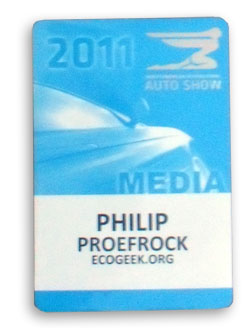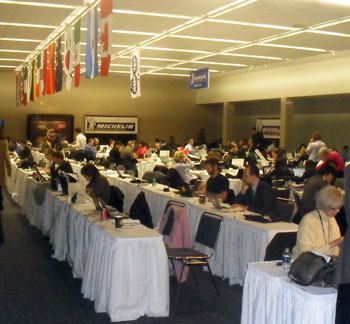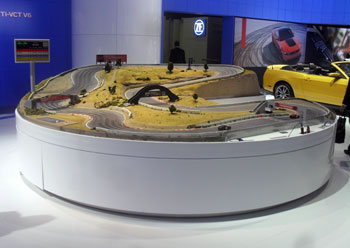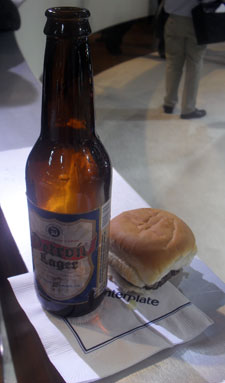Column: Accidental Auto Journalist
I am not a journalist – I just play one, as the saying goes.

The author's media credentials for the North American International Auto Show. (Photos by the writer.)
So what was I doing at the Press Preview of the North American International Auto Show a few days ago at Cobo Hall? Even though I’m an architect in my day job, I also do some writing for EcoGeek.org, a blog focused on issues of technology and the environment. And I’ve also contributed to several other online media outlets in the past few years.
My writing sideline started with a focus on green building technology. But because of my proximity to Detroit, I found myself receiving forwarded invitations to auto industry events.
So while I’ve never particularly thought of myself as a “car guy,” I’ve come to find myself acting in the capacity of an automotive journalist. I have now attended the North American International Auto Show three or four times as a member of the press.
Despite having developed some familiarity with the process, I still feel like an interloper – as though I’m getting away with sneaking in someplace I’m not supposed to be.
Auto Show Credentialing
Gaining admittance to the auto show as a journalist is a multi-step process. In order to get a media credential, I filled out my application back in December. I submitted the application, along with copies of three recent auto-related articles I had written, as well as an assignment letter written by my editor to the show’s organizers. Because I have attended a couple of years previously, I think this was easier than in previous years – but it’s still the same process. A few days later, an email arrived saying that my credentials were approved.
On Monday, Jan. 10, I arrived at Cobo Hall before the sun was up to spend my day at the show – though not early enough to attend the 6 a.m. “Porsche Breakfast.” Once inside the building, the first order of business was to pick up my press credential at the ticket window.
Already at that point, the international scope of the show was apparent, as a group of four or five men in front of me conversed in Spanish. They were from Argentina, which I deduced from one of their passports. Then, after obtaining the badge, I had to show it, plus a photo ID, to another official in order to get a wrist band. The wrist band let me get through the doors and onto the show floor. Presumably this keeps people from swapping badges to let others into the show.
After clearing all of these hurdles, I walked through the doors and joined the other journalists for the Press Preview.
Auto Show Marketing Campaigns
I encountered the first marketing campaign even before I got to the line to get my credential badge. Stands with free copies of the Wall Street Journal were wrapped with an ad with Toyota’s tagline for this year’s show, “What’s the plural of Prius?”
Once inside, I decided to just walk a big loop through the entire show to get a sense of what the different manufacturers are promoting and to get an idea of what things I would like pursue further. The number of electric cars seemed to be a key theme last year, and even more electric vehicles are here this year – but they seem to be less in the spotlight, maybe because we learned so much about them last year.
What’s the difference between the Press Preview and the show that’s open to the general public? For one thing, you get to walk through the show with a relatively open floor. I’ve also attended the show during the days it has been open to the public, and it is much more crowded then than it is during the Press Preview.
The other key feature of the Press Preview is the company information that is provided to journalists. Throughout the day, press conferences are scheduled by different manufacturers, and hundreds of journalists will converge on that manufacturer’s booth to hear the presentation. They often include self-congratulatory sales information from the previous year, as well as some information about the company’s strategy and new model plans.
These conferences are little theatrical productions unto themselves. They are the kind of events when new models or concept vehicles are dramatically undraped with great flourish.
Even if you don’t have a copy of the floor map and the schedule of these conferences, you can tell when and where the next press conference is going to be held as the time nears: The current of people moving in one direction is a clear sign, as many of the attendees converge on the space for the next scheduled announcement.
Music precedes the introduction of the first speaker, who often has a title with labels like “executive,” “vice president,” “marketing,” and “corporate communications.” Lots of bass seems to be a musical requisite. Audi’s introduction featured lots of thundering drums, making it seem like an outtake from Battlestar Galactica – all the more when last year’s E-tron model was introduced. Theatrical lighting, large display screens, video clips, and little over-the-ear, foam-covered microphones also seem to be regular parts of these productions.
Some press conferences feature two or three different speakers, with one presenter talking about the company and the next introducing a new model, or speaking more about the new features the company is emphasizing.
Behind the scenes, some of these productions also have lavish and extensive production teams. A video production booth – that wouldn’t be out of place at a live sporting event – runs the show with a team of technicians, shifting between two or three cameras for alternating shots on the large screen displays of the speaker and the cars. They also cue the video clips showing cars out on the road or demonstrating particular features of a vehicle.
One of the last conferences of the day was BYD (Build Your Dreams), a Chinese automaker that began as a battery manufacturer. BYD was on the main floor of the show for the first time last year. The company is building hybrid and electric vehicles for China and is trying to move into the American market as well. BYD has begun its first testing in the U.S. with its F3DM hybrid car, which is being used in a fleet test with the Housing Authority of the city of Los Angeles. The director of the housing authority appeared on stage to speak briefly about the cars.
The production values of the BYD presentation, as well as their booth, were not as elaborate and refined as many other exhibitors. Much of the BYD presentation was about their “3 Green Dreams,” which includes development of low-cost solar power systems to generate electrical energy, and electrical energy storage using environmentally friendly materials, along with an electrified vehicle fleet. BYD’s presentation included talk about integrating these three technologies, but only in very general terms, and without technical or commercial specifics – which made it seem much more like a political address than a business presentation.
Press conferences at the auto show serve as theater not just for the reporters in attendance, but also for a broadcast audience. This year’s Honda presentation was only partly about their cars – the 15-minute program included several minutes worth of talk about the Honda Civic concert series. Honda brought in Pete Wentz, member of the currently on-hiatus band “Fall Out Boy,” to announce a social media promotion encouraging people to compose songs about the Honda Civic. Indirectly, this is part of the corporate marketing, of course, and it serves to promote the name of the car. But it seems off topic for an automotive show.
Media Amenities
To post a story during the show, I need to use the press room, located on the third floor. I wasn’t even aware it existed the first time I attended, but I have since learned that this space is available to those of us with a press badge. It’s a very large space filled with tables and chairs for several hundred reporters, photographers, videographers, radio correspondents, and bloggers. The polyglot nature of the show is reinforced both by the numbers of national flags hanging from the ceiling overhead as well as the languages one overhears walking through the room.
A couple years ago, while I was writing and posting a piece for my blog, I heard how a radio reporter at the table behind me did repeated takes for a piece he was assembling for his program.
Ethernet cables and power strips cover the tables, allowing a data connection to the outside world, if you can find an open seat. Since I wanted to be able to post at least one story on the day of the show, after a few hours I made my way upstairs to the press room to write the article, as well as to have a chance to sit for a few minutes before heading back to the displays.
While a few years ago it was common for the different automakers to fly in bloggers from different outlets around the country, that has seemed less prevalent over the past couple years, though the practice still exists. When the owner of EcoGeek – the blog I write for – attended the auto show a few years ago as a guest of an automaker, it marked the only occasion I’ve met him in person.
I have also been invited on a couple of trips to other locations, and in those instances, my editors and I have disclosed the interest of the company involved in providing the invitation. But in this case, as I live in Ann Arbor, there was no need for anyone to fly me in to Detroit to cover the show, and EcoGeek will cover my expenses. I have always tried to be unbiased about my writing in any case, and although no one is paying me to write favorable things about them, I still find myself wanting to be extra clear about this.
There are still small gifts and tsotchkes the manufacturers hand out to publicize their products. The press kit has gone from the printed page (though there are still loads of printed brochures to be found) to CD- and DVD-ROMs, with high-resolution, print-ready copies of the publicity photos of all the new cars (though some manufacturers still have these, too) to USB thumb drives, which are the latest trend, and have been increasingly distributed for the last couple of years.
Sometimes the memory stick is packaged in a way to try to make it memorable. Fiat’s tiny flash drives were tucked into a bed of confetti inside an espresso cup and saucer set. Hyundai’s drives were in Swiss-army tools that also include a pen and LED light. Buick’s flash drive is in a wooden swing-out case. Others are simply prominently branded with the company logo.
Some manufacturers offered journalists other amenities to induce them to spend more time at their displays. Accura offered an espresso bar serving cappuccinos, lattes and mochas.
Toyota provided a table with charging stations to recharge cell phones and personal electronics, and a couple of computers for online access. These seemed to be popular with some journalists who wanted to check their flight plans.
Both of those features will likely have been reconfigured to provide additional space for the sales representatives, now that the show is open to the public.
Hands-On Fun
The lower level of Cobo includes a driving track with a number of vehicles that attendees can drive – after signing a liability waiver and taking a breathalyzer test. This year has fewer vehicles than last year, when nearly two dozen hybrid, fuel cell, and electric cars and trucks were on display and available for test drives.
Some vehicles appear only at the show for preview week and will not be available for the general public to drive. AMP, a small company that converts cars to battery electric drive, was there with a converted Chevrolet Equinox that they are starting to produce for some consumers. The converted Equinox has a 100-mile range.
Protean Motors featured a demonstration Ford F-150 pickup with its engine removed, replaced by four in-wheel electric motors to power it. Both AMP and Protean are only appearing at the preview week, and will not have their vehicles available for the public to drive. But they were attending the show in order to show their products to manufacturers and industry insiders, as well as to curious journalists.
I drove the new Chevrolet Volt, which I have been following and helping to report on since it was unveiled as a concept car. The Volt, as well as the Ford Fusion and several other cars, are available for test driving during the public show, which opened on Jan. 15 and runs through Jan. 23.
The basement area is also home to the “Smarter Living in Michigan” show, which stretches beyond cars and trucks to feature a range of displays from LED lighting and log homes to automotive battery system manufacturers and wind turbines. Also on display: a truck designed to run on biogas generated from waste material; the University of Michigan solar car; and Current Motor’s electric scooters.
It struck me that this is a good year for kids at the show. Games and interactivity seem to be a popular theme with several of the exhibitors’ displays. Chevrolet has a driving game featuring the Chevy Volt that uses the Kinect for Xbox to allow two players at a time to race side-by-side, pairing the new automotive technology of the Volt with the new electronic entertainment technology of the Kinect.
Camaro includes a display that is ringed with cameras to take a 3-D picture as the subject jumps in the air in front of the car, giving you a “bullet-time” image that pans back and forth, showing you suspended in space. This example features science-fiction author Tobias Buckell and a couple of his friends: [link].
Ford has a truck-driving simulator mounted on a motion-control rig with three monitors for a widescreen display. The game was a timed race with the driver steering a simulated Ford truck along a dirt road – a motion-control simulator banks and swivels the seat to give the driver a sense of motion. Another Ford video game features an overhead view of a city and requires the driver to hit different checkpoints.
An impressively large, 4-lane slot-car racetrack helps promote the Ford Mustang.
Both Ford and GM are also notably tying back to their past with historical models on display. Ford is showing a 1960s Lincoln in that part of their display, and GM is featuring a 1950s Thunderbird in the Chevrolet display. The requisite movie car tie-in at this year’s show is satisfied with the car from “The Green Hornet,” on display in the lobby area of Cobo Hall.
Winding up the Day
Chevrolet was the last press conference of the day last Monday, starting at 6:15 p.m. Hundreds of reporters and photographers were already filling the seats by the time I got there, and I joined the throng standing to the sides to watch as a group of musicians performed with a variety of mobile electronic tablets and phones.
Three new Chevrolet Sonic models drove onto the stage behind the musicians. As the cars rolled onto the stage, dozens of cameras were held aloft, reminiscent of concertgoers with lighters, as people in the deeper rows tried to get the first pictures of these cars. Sonic executives then gave another version of the same kind of pitch I had heard a half dozen times already. They were excited about how solid the past year’s sales had been, they thought the new models were wonderful, and they would produce future models that would be just what the car-buying public needed.
The speeches ended with a mass of photographers rushing the stage to crowd the new cars while other reporters crowded the press counter for one more flash drive.
Tables were set up nearby with bottles of Detroit Lager and waiters circulated through the crowd with trays of gourmet sliders for the assembled crowd.
Both the press and the industry people seemed to be glad that the whole event was over, and I saw lots of small groups talking shop among themselves. Some company people were giving follow-up interviews to reporters, while other groups of industry people chatted together; two reporters were talking about website design services.
Twelve hours after I had arrived, I finished my slider and headed back into the night to drive home and hang up my automotive journalist’s hat for another day.
EcoGeek articles by the writer from this year’s auto show:
- Chevy Volt Is 2011 North American Car of Year
- Toyota Searches for a Plural for Prius
- Green Cars at NAIAS 2011
- Efficient Conventional Cars at NAIAS 2011
- Ford Goes After Both Hybrid Competitors with One Car
The North American International Auto Show, located at Detroit’s Cobo Hall, is open to the public through Sunday, Jan. 23. More details are on the NAIAS website.










Isn’t the Thunderbird a Ford product? Why was it at the GM display?
I think you’re absolutely right! See, I told you I’m not that much of a car guy.
I’ve tried to search a bit and see if I could properly identify the car that was on display as part of the Chevrolet exhibit, but I haven’t found it yet. Can someone else help out with the correct identification of the historical car they had there?
If I were Chevrolet, I would make it a ‘vette.